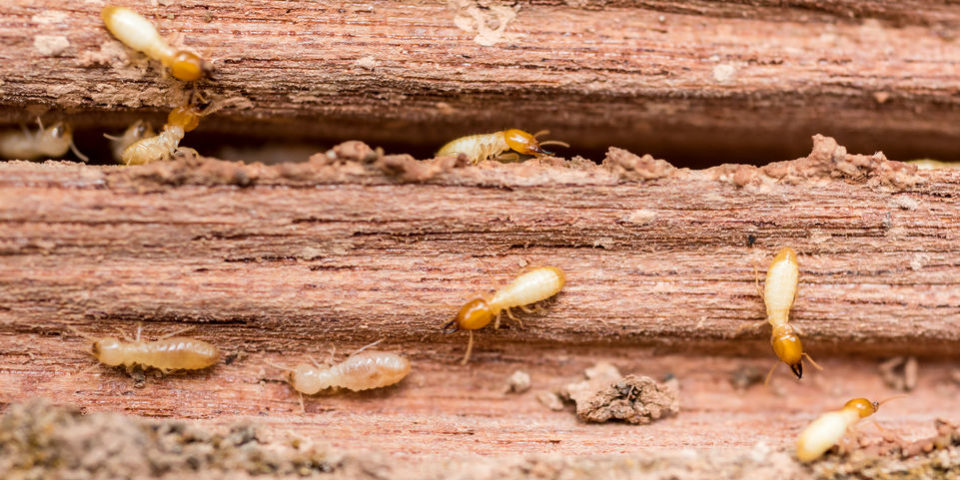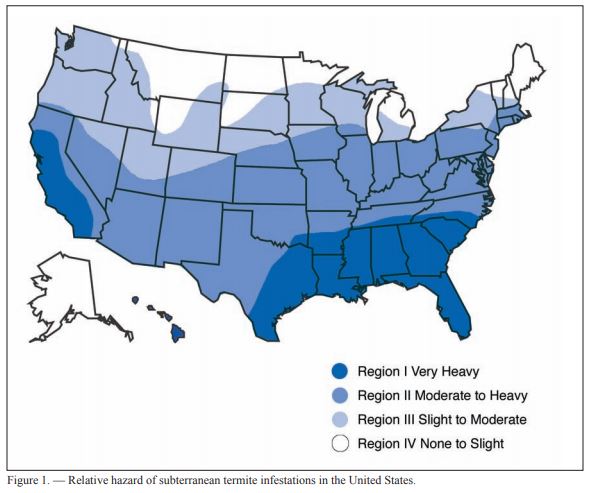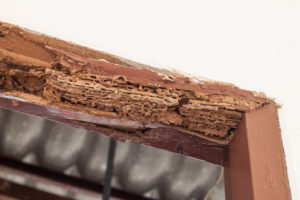Termites are known as “silent destroyers” because of their ability to chew through wood, flooring, and even wallpaper, all while being undetected. Termites can cause thousands of dollars in damage to a house, depending on the colony’s age and location. According to the National Pest Management Association, termites cause more than $5 billion in damage each year. Most of the time, termite damage is found only after it’s too late. Termites can be hard to find with the naked eye, and it can take 3-8 years before signs of an infestation even show up. By knowing the signs of a possible termite infestation, you can help your client mitigate the issue before it goes too far.
What is a Termite?
Termites, or wood-destroying organisms, are insects that feed on cellulose in plant material like wood, soil, and dead leaves. A large colony can consume a pound of cellulose a day, but it’s usually much less. Termites usually come out in early spring, and are often confused with a swarm of flying ants. They eat wood from the inside out, so there is often very little evidence of an infestation until it’s too late.
Termites live in large colonies, and consist of three different roles:
- Worker termites are white to gray in color and make up the largest population of a colony. They are responsible for eating away at wood or other plant material.
- Soldier termites are larger and yellow-brown in color. They protect the next and repair damage to the termite’s home.
- Swarmer termites have wings and may be yellow or brown. They are the breeders of the colony.
The termites that are the biggest threat to homeowners in the U.S. are:
- Damp wood. Damp wood termites tend to live in areas that are heavily forested.
- Dry wood. Dry wood termites live in really dry wood, and are rare in the U.S.
- Subterranean termites are the most destructive. They require a moist environment and are usually found living in the soil.
- Formosan termites are the most aggressive. They organize into huge underground colonies and build intricate mud nests inside the walls of a structure. Because they are so aggressive, Formosan termites are difficult to control once they infest a structure.
- Conehead termites are an invasive species native to the Caribbean that was first introduced to the U.S. in 2001. They forage on the ground like ants, allowing them to spread quickly. They are extremely aggressive and can cause widespread property damage in a short period of time.
This map was developed by the US Forest Service in the Home and Garden Bulletin 4 Subterranean Termites –
Their Prevention and Control in Buildings. It shows that subterranean termites are a problem almost nationwide.
Where Can Damage Be Found?
Crawl spaces are notorious for moisture problems. They’re usually caused by things like poor control of storm water runoff, condensation from ductwork, and inadequate ventilation, just to name a few. Moisture creates the perfect environment for termites and wood-destroying organisms (WDO).
Other locations where a termite infestation may be located include:
- Inside wall cavities
- Ceilings
- Flooring
- Wood siding
- Firewood stored against a home
- Mulch or other landscape material near the home
- Window frames
Even if there is no wooden framework on your home, termites can still get in. You can read more about how in our blog post “Can Termites Infest Masonry Homes?”
If a home inspector identifies termite or WDO activity during a home inspection, they’ll suggest that their client hire a pest control contractor for proper assessment and treatment. Depending on the amount of damage present, a building contractor or structural engineer may need to be brought in to assess the condition of the home and determine the best way to mitigate.
If you want to read more about warning signs, jump over to our blog post, “Five Signs Termites are Invading Your Home”.
Can a Home Inspector Perform a Termite Inspection?
Some home inspectors also hold a termite inspection license, but most don’t. National organizations like the International Association of Certified Home Inspectors (InterNACHI) and the American Society of Home Inspectors (ASHI) have training courses that teach home inspectors how to identify WDOs, but these courses do not certify a home inspector to produce a WDO inspection report. The license needed to produce the report typically comes from licensed pest control companies, as a termite home inspection is a specialized field.
A home inspector examines a home’s structure and its systems for defects. This includes things like the construction elements, electrical, plumbing, HVAC systems, the roof, interior and exterior components, and foundation. A home inspection report is much more detailed than a termite inspection, because a home inspection covers almost every aspect of the house, whereas a termite inspection will be specific to termites.
A termite inspector has one focus – to look for evidence of wood-destroying organisms in and around the home. While a home inspector usually inspects using the “Outside-In, Top-Down” approach, a termite inspector starts at the bottom and moves to the top, going from basement/crawlspace to attic.
What to Watch Out For
Home inspectors check for signs of moisture in and around a home, not just because it can cause foundation issues, but because termites love damp conditions. Subterranean termites especially love moisture, so it’s important to identify moisture build up in and around a home. Areas to keep an eye on can include dripping from an outside faucet or clogged cutters that don’t drain properly.
Evidence of termite damage can include things like:
- Buckling floors
- Dry rot in wood floor joists
- Wood rot in door and window frames
- Soft/damp wood
- The presence of mud tubes bored into the soil near the foundation or directly into the home
- Swarms around indoor or outdoor lights
- Small mounds of what looks like sawdust
You can read more about “What You Need to Know About Inspecting for Wood Destroying Organisms” here.
Termites can be a big problem, but knowing some of the warning signs can help you identify potential issues for the home, so that the owners or potential buyers can get a professional termite inspection to locate any infestations that may be present.
Inspection Certification Associates offers a bonus course on Wood Destroying Organisms, which is a good option for inspectors who want to learn more about termites, ants, bees, and other creatures that cause property damage.
And if you’re ready to get started with an exciting career in home inspection, let us know! We’d be happy to answer any questions you have, and help you get enrolled in the course that meets your state’s needs. Feel free to reach out by phone at 888-374-4096 or [email protected].










